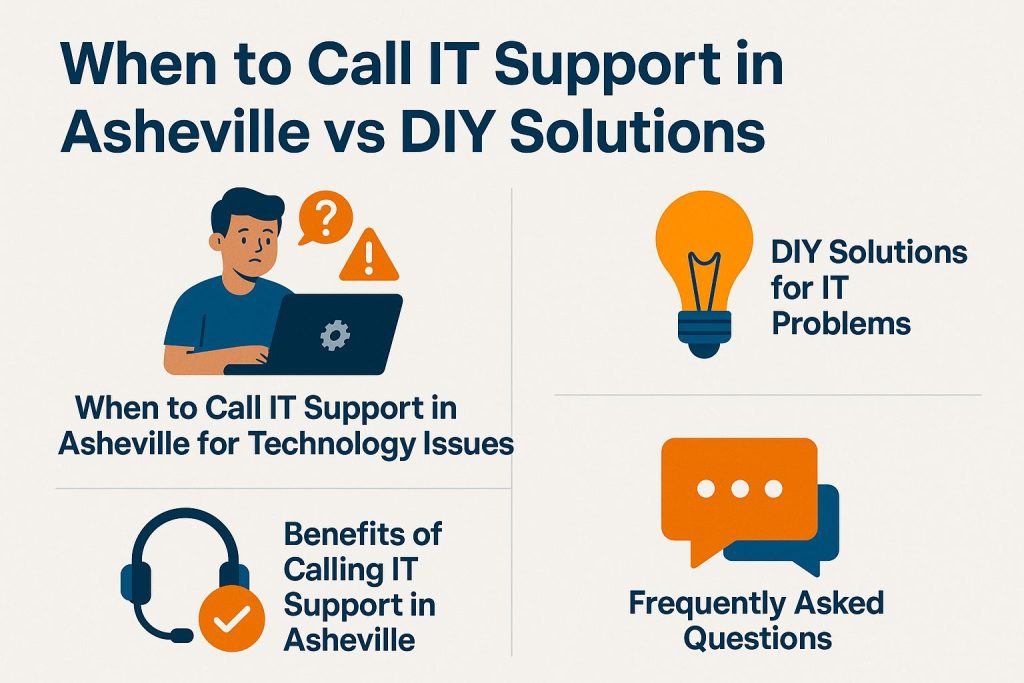Job Site to Office: Integrated IT Solutions for Asheville’s Construction Companies

Integrated IT solutions for Asheville construction companies are essential for connecting job sites and offices, improving communication, project management, and overall productivity. These solutions help streamline workflows, reduce costs, and enhance collaboration across teams
This guide explores key features of integrated IT systems, including cloud platforms and mobile apps, and offers practical steps for implementation.
For related IT insights, visit IT Support Services Tailored for Asheville’s Growing Small Business Community.
Overview of Job Site to Office Integration
Integrated IT solutions for Asheville’s construction companies play a vital role in modern construction management. Leveraging tools like construction management software and building information modeling (BIM) enhances project coordination, improves data accessibility, and helps teams identify potential issues early.
Advanced collaboration tools ensure that teams at both job sites and offices remain connected, fostering seamless communication and efficient project execution.
Benefits of Integrated IT Solutions
Integrated IT solutions enhance efficiency and project outcomes for construction companies. By utilizing advanced collaboration tools and project management software, these businesses can improve communication, streamline workflow automation, and ultimately achieve cost savings and heightened productivity.
Organizations that embrace these digital tools for construction can manage resources more effectively, optimize project tracking, and ensure superior subcontractor management. Additionally, the implementation of mobile workforce solutions enables remote access, allowing teams to collaborate seamlessly, even while working on-site.
Streamlined Communication and Collaboration
Effective communication is vital for construction projects and encourages teamwork among stakeholders. By utilizing collaboration tools and digital platforms, construction teams can enhance real-time communication, facilitating quicker decision-making and improved project management.
For example, integrating communication platforms with project management software allows project managers to efficiently track tasks, monitor progress, and communicate updates to the team. This level of connectivity is particularly advantageous on construction job sites, where remote access to information ensures that everyone remains aligned and informed, thereby enhancing team collaboration.
The construction industry frequently faces communication challenges, such as fragmented information flow, language barriers, and difficulties in coordinating among a diverse workforce. To address these issues, many firms have successfully implemented tools like Slack and Microsoft Teams for instant messaging, while also leveraging Building Information Modeling (BIM) for visual communication.
These platforms connect on-site and off-site teams, aligning architects, engineers, and contractors.
A notable case involves a large-scale infrastructure project in which the adoption of these technologies led to a 30% reduction in project delays and a significant increase in worker productivity. This example underscores the substantial impact that effective communication strategies can have on the execution and success of construction projects.
Efficient Project Management
Efficient project management is key to completing construction projects on time and using resources well. By implementing advanced project management software, construction companies can enhance their project tracking capabilities, streamline scheduling, and optimize resource management.
This approach provides better visibility into project lifecycles, allowing managers to identify potential risks and proactively adjust plans. The integration of predictive analytics into project management processes can greatly enhance decision-making and operational efficiency.
Project management methodologies like Agile and Lean construction improve collaboration and reduce waste. These methods, along with tools like Building Information Modeling (BIM) and collaboration platforms, help teams coordinate better and stay productive.
Technology adoption is important for accuracy. It helps collect and analyze performance metrics. Construction analytics provide stakeholders with insights. These insights inform strategic decisions, improve project outcomes, and enhance client satisfaction.
Cost Savings and Increased Productivity
Integrated IT solutions can save costs and increase productivity in construction. Companies that embrace digital transformation find their processes streamline. This leads to better resource management and less waste.
Using ERP systems, organizations collect performance metrics. These insights show areas for improvement and boost overall productivity. These examples show how specific technologies and strategic planning can improve financial performance and operational efficiency in construction.
For example, a prominent construction firm adopted an integrated project management system that centralized data access and communication among diverse teams. This initiative resulted in a 20% reduction in project delays and a 15% decrease in material costs due to more accurate tracking and forecasting.
Similarly, another company that implemented drone technology for site surveys reported a 30% improvement in productivity, as it facilitated faster inspections and precise data collection, significantly reducing the time spent on manual processes.
These examples underscore how specific technologies, combined with strategic planning, can enhance financial performance and operational efficiency within the construction industry.
Key Features of Integrated IT Solutions
Key features of integrated IT solutions include tools that improve efficiency and collaboration in construction.
These features include cloud computing, which offers scalable resources for data storage and accessibility, as well as mobile applications that enable teams to manage tasks effectively on-site.
Furthermore, the incorporation of data analytics tools enables construction companies to make informed decisions based on real-time information, ultimately resulting in improved project outcomes.
The integration of these technologies ensures seamless communication and collaboration, which are essential in today’s fast-paced construction environment.
Cloud-based Platforms for Remote Access
Cloud-based platforms have significantly transformed the construction industry by offering remote access to crucial project data and resources. This technology enhances IT infrastructure, enabling construction companies to securely store and manage large volumes of information.
With the capability to access project management software and collaboration tools from any location, teams can maintain connectivity and stay informed, thereby improving their overall construction management processes. Additionally, cloud computing bolsters data security, ensuring that sensitive information is safeguarded against cyber threats while facilitating seamless communication between on-site and office personnel.
The benefits of cloud technology extend beyond accessibility; they cultivate a culture of collaboration and real-time decision-making among team members, irrespective of their geographical locations. For instance, firms that have implemented cloud solutions often observe a notable reduction in project delays, as team members can swiftly update progress, share documents, and resolve issues as they arise.
However, these platforms have challenges. Data security is a priority. Companies must comply with regulations and protect sensitive data from breaches.
Balancing the integration of advanced tools with robust security protocols is essential for construction firms aiming to maximize efficiency while safeguarding their information.
Real-time Data Sharing and Tracking
Real-time data sharing and tracking are vital for integrated IT solutions. They help construction teams stay informed about project progress and make quick decisions. Using advanced construction documentation tools helps teams ensure all stakeholders have the latest information. This boosts digital collaboration.
This capability improves project tracking. Managers can monitor performance metrics and spot potential issues early. Real-time data sharing promotes a proactive approach to construction management. This leads to better project outcomes.
Tools such as Procore and Buildertrend serve as prime examples of how technology can streamline communication, allowing team members to access critical updates from virtually any location.
When performance metrics—such as budget variance and schedule adherence—are continuously monitored, construction managers are better equipped to make informed decisions that mitigate risks at an early stage. This capacity for swift adaptation not only enhances operational efficiency but also fosters accountability among team members.
Consequently, organizations that prioritize real-time data sharing are likely to experience faster project deliveries, along with improved quality and safety standards throughout the construction process.
Mobile Applications for On-site Management
Mobile applications are essential for on-site management in construction. They help teams manage tasks and collaborate from any location.
These applications automate workflows. Workers can input data, track progress, and access project documents on-site. Construction companies that utilize mobile workforce solutions can significantly enhance team collaboration and efficiency, as real-time access to information ensures that all members are aligned and can respond promptly to any changes or challenges.
The versatility of mobile applications such as Procore and PlanGrid offers a range of features for document sharing, project scheduling, and issue tracking, which greatly streamline operations.
For example, Procore enables project managers to oversee timelines and budgets in real-time, facilitating quick adjustments that help minimize delays. Meanwhile, PlanGrid improves communication between field workers and office staff.
These tools improve team coordination and productivity by reducing paperwork and waiting times, leading to better project success.
Implementation and Adoption of Integrated IT Solutions
The successful implementation and adoption of integrated IT solutions require careful planning. This helps construction companies maximize technology benefits.
Start by evaluating the current IT infrastructure. Identify areas for improvement and engage technology consultants for insights. Engaging technology consulting services can offer valuable insights into best practices for integrating new systems and promoting a culture of change management within the organization.
By prioritizing employee onboarding and training, companies can ensure that their teams are well-prepared to effectively utilize these integrated IT solutions, facilitating a smoother transition and fostering long-term success.
Steps for Successful IT Integration
Integrating IT solutions in construction requires strategic steps. These ensure a smooth transition and effective use of new technologies.
The initial step involves conducting a comprehensive assessment of existing workflows to identify potential gaps that technology adoption could address. Following this assessment, it is crucial to develop a clear implementation plan that outlines timelines and resource allocation. Engaging IT support and establishing risk management strategies can help mitigate potential challenges, leading to a more effective integration process.
This process may involve detailed mapping of current procedures to identify inefficiencies that new systems could rectify, such as delays in communication or data processing. Once these areas are identified, it is important to prioritize the technologies that will have the most immediate impact, such as project management software or mobile field solutions.
Collaboration with IT teams should then focus on configuring these tools to meet the specific needs of construction projects.
Incorporating training sessions for staff is essential to facilitate smoother adoption, as employees often serve as the first line of defense against integration issues.
Ultimately, maintaining a feedback loop with IT support provides insights into risks. It allows for proactive adjustments and ensures continuous improvement in a technology-driven landscape.
Training and Support for Employees
Training and support are essential for adopting IT solutions in construction. Investing in training helps employees use new technologies effectively, improving performance and productivity.
Technology consulting services can develop tailored training programs for specific team needs. Focus on performance metrics to assess training impact. Ongoing support helps employees overcome challenges, fostering continuous improvement.
This approach streamlines onboarding and builds confidence in employees. Hands-on workshops and interactive e-learning modules cater to diverse learning styles, allowing employees to master technologies at their own pace.
Creating supportive communities through mentorship and collaboration enhances knowledge sharing and peer support.
To evaluate training effectiveness, use metrics like productivity rates, employee satisfaction surveys, and feedback scores. Regularly assess engagement and skill acquisition to refine training strategies.
Conclusion: Advancing Asheville’s Construction Industry
Adopting integrated IT solutions for Asheville’s construction companies improves communication, project management, and productivity. By leveraging cloud platforms, mobile apps, and real-time data sharing, businesses can enhance efficiency and stay competitive.
For further insights, explore How Asheville’s Mountain Terrain Affects IT Network Reliability.
For national construction IT trends, visit Construction Executive: Technology.
Frequently Asked Questions
What is the integrated IT solution for Asheville’s construction companies?
This solution connects job sites and offices with technology. It makes processes more efficient.
What are the key features of this solution?
Key features include remote job site data access, real-time project updates, electronic document management, cloud storage, and secure communication.
How can this solution benefit construction companies in Asheville?
This solution benefits construction companies by reducing paperwork, eliminating data discrepancies, improving communication, and increasing productivity.
Is this solution customizable for individual construction companies?
Yes, this solution is customizable to fit each construction company’s needs. Our team collaborates with you to tailor the solution.
What kind of support and training is provided with this solution?
We provide technical support and training for installation, setup, and maintenance. Our team is available to assist with questions and issues.
How can construction companies in Asheville implement this solution?
Implementing this solution involves setting up hardware and software, training employees, and integrating it into your workflow. Our team guides you through the process.




